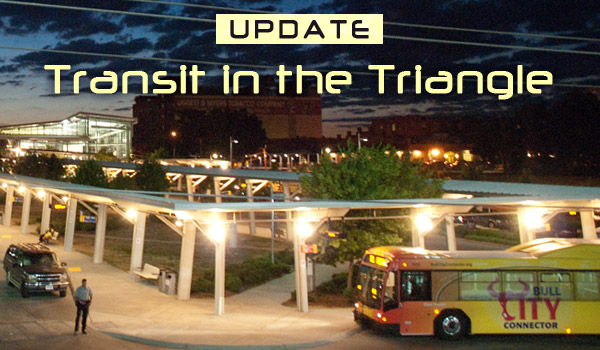Transit in the Triangle
Morrisville, NC — Triangle Transit CEO, David King, recently spoke at the Morrisville Chamber to give the audience an update on how the Triangle is doing with regard to mass transit. The region’s population is expected to double by adding another 1.3 million people over the next 20 years. It’s safe to say, “We are behind” when it comes to mass transit planning. Triangle Transit oversees transportation issues for three counties including Durham, Wake and Orange. They are a regional organization charged with planning for the region’s transit problems. They don’t yet cover Johnston County, but maybe that’s only a matter of time. The Triangle Transit organization looks at heavy transit routes and begins to make plans for whether rail, bus, carpool lanes or van pools are the answer depending on roads and availability of existing services.
Wake Needs A Plan
Only Durham and Orange have already passed a 1/2 cent sales tax to help pay for future transit needs. That plan includes 17 miles of light rail with 17 stations. It will connect NCCU, Duke, Duke Hospital, Downtown Durham, UNC-CH, and UNC Hospital. The plan was put to the voters and approved by over 69%.
Wake Commissioners are just now ready to take up the issue of mass transit planning and are expected to hire a consulting firm within the next few weeks to begin a new Wake County plan. A draft plan is hopefully to be issued in March of 2015. That will include Wake County, Triangle Transit, Capital Metro Planning, the City of Raleigh, Town of Cary, NC State, RDU and RTP.
Transit Brings Development
One fact that needs to be emphasized, according to King, is that where transit hubs are created, economic development follows. Hubs interest developers, who then build housing and shopping , and they can greatly re-energize an area, especially poor quality, under-utilized downtown areas. King went on to point out how the light rail in both Charlotte and Atlanta have renovated former brownfield areas and turned them into upscale development.
Not One Fix
There is not “one fix” to our traffic/ transit woes, and some situations will call for an innovative approach. One such idea has been allowing buses to ride on the shoulders of highways and interstates. there are already 25 miles of these in North Carolina and in 2 years there have been no safety issues. Express buses are another solution. They have added apps to allow passengers to feel less stressed about the arrival of their bus, which can see the route in real time.
One of the key threads for the new Wake County transit plan will be to identify key corridors, and assess demand. There will be a focus on bus frequency. Our bus service ridership “is near the bottom” for use and service. Rail service is in the mix with hopes of a Wake-Durham commuter rail line that will include two stations in Garner, Downtown Raleigh, NC State, 2 stops already planned in RTP, a west Raleigh stop, Cary Downtown, Mc Crimmon in Morrisville, Downtown Durham and West Durham. This proposed line would cover over 37 miles. The plan is to partner with Norfolk Southern who owns the corridor.
We are Behind
Even with plans underway, it takes years to purchase right of ways, make routes, and for rail to be built. Even if a tax is approved by voters, it takes a year before the fund start to be collected. King asserted that light rail takes at least a decade to be built. And by then the Triangle will have added half of those 1.3 million people. All driving their cars to and from work.
More Food for Thought
A recent report from Wake Up! Wake notes that
- There is a huge mismatch between where Americans live and where they want to live.
- 58% of survey respondents say their ideal neighborhood has a mix of housing, offices, and retail, but only 39% currently live in such a neighborhood.
- Urban, suburban, and small-town mixed-use neighborhoods are all under-supplied, and Americans of all age groups want them.
- The most “over-supplied” type of neighborhood is the residential-only suburb. 30% of respondents currently live in a residential-only suburb, but only 16% say their ideal neighborhood is a residential suburb.
- Young people are far more likely to use transit than older people.
- This suggests that places that are using transit to attract young people shouldn’t worry that young residents will leave after they start families. (At least, not because they will abandon transit — there may be other concerns, like schools.)
- Americans in all age groups agree on the four most important improvements that would make them ride transit more: Shorter travel time, stations that are closer to where they live or work, lower cost compared to the alternative, and reliability. This supports transit projects that improve travel time (like new bus rapid transit or rail projects) and expand access to transit to more people. It supports walking and biking improvements that make it easier to access stations, as well as projects that improve service reliability.
Wake County Commissioners have the opportunity to plan for the future growth of this area, and get it right. We may be behind in our planning for our area’s huge growth, but that shouldn’t mean our officials do nothing. The quality of life that brings so many people here in the first place will suffer if we do not adequately plan for our future.
—————————————————————————————
Story by Lindsey Chester. Photo by Hal Goodtree.




First of all, EcoPRT will not solve any problems for the $2 million they are claiming. That is a completely ridiculous claim. Now, they may have incredible tehcnology and great innovative solutions to problems encountered by others. But still, when they are building a system that could literally kill its occupants, I should hope they will spend at least $2 million to develop and test the software and control systems alone. You can’t cut corners on that stuff. Do not give them one ounce of attention until they come back with a realistic plan for how much this will actually cost.
Second of all, these sort of vehicles will not be fast enough to solve any problem other than “last mile” distribution, and we already have a reasonable solution for the “last mile” issue – walking. Sure, Centennial to Main Campus is a bit of a hike, but then again, buses work pretty well for that.
So, in my mind, PRT is largely a solution in search of a problem.
an update on EcoPRT
http://www.bizjournals.com/triangle/blog/techflash/2014/10/ecoprt-nc-state-raleigh-transit-system.html
disclaimer: I worked for HowStuffWorks in 2000-2001
EcoPRT looks like a nifty people moving system, if all you want to do is move people. But I have my doubts on how well it will handle a mom and three kids coming home from the grocery store with a bunch of bags. That’s scenario seen fairly often on C-Tran, TTA, and I suspect other area bus systems. Or someone like me trying to get half a dozen six foot 1″x4″ pieces of wood home from Home Depot.
As for the comment in the article, “Young people are far more likely to use transit than older people.”, I don’t agree.
A lot of it has to do with the systems operating hours. Since C-Tran extended it’s hours I’m seeing a lot of seniors, including myself, using the system to get to the Cary Arts Center, Bond Park Community and Senior Centers, the theaters in Crossroads, and many other places they were shut out of under the old hours. The problems with TTA for Cary seniors are the 301 and 305 routes effectively shut down for 7 hours in the middle of the day, and they quit running way to early. Which is a pain if you’re trying to get to or from the Eva A. Perry library across from the Lake Pine Plaza bus stop. Never mind to or from Raleigh.
Or, the non-government-subsidized approach?
Watch the video for a quick, 3-minute overview of EcoPRT:
http://ecoprt.com/video/
The goal of EcoPRT is to create a new, light-weight, low-cost transportation system with the smallest possible footprint, so that it can be installed almost anywhere on existing rights of way. With a target price of just $1 million dollars per mile of guideway, EcoPRT installs quickly and can be repositioned when needed. EcoPRT vehicles are small and lightweight with a target price of just $10,000 dollars each. Because of the small vehicle size, EcoPRT stations are also small an inexpensive. They can be located at close intervals, in existing parking structures and even inside buildings.
Good for Cary for having this conversation. On one Good Housekeeping Magazine measurement of walkable/bike-able, etc. communities Raleigh rates a bit higher than Charlotte, but there are no stats for Cary yet. Author Jeff Speck in his book Walkable Cities finds some surprising and counterintuitive conclusions about walking, biking, mass transit. A great read.